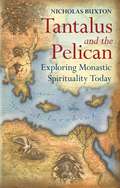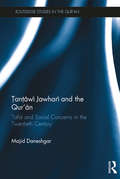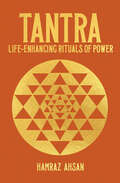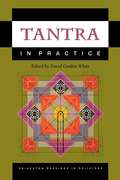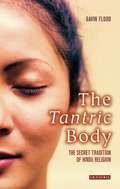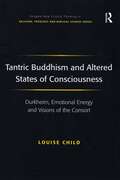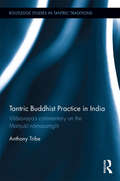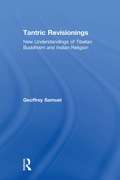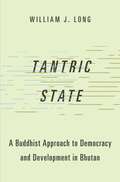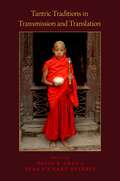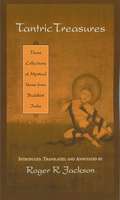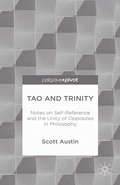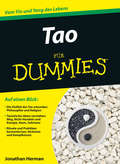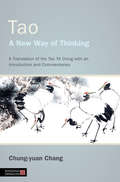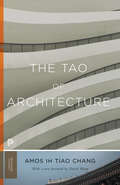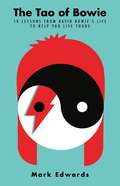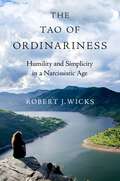- Table View
- List View
Tantalus and the Pelican: Exploring Monastic Spirituality Today
by Nicholas BuxtonThis is an informative and engaging book about monasticism, its history, practice, and relevance to contemporary life, combining personal insights with sound scholarship. Buxton begins with a focus on the early days of Christian monasticism and the transmission of this tradition to Western Europe, concentrating on particular themes or figures of interest and seeking to draw parallels with the present-day. He then explores the central features of monastic life, such as silence and humility, drawing on personal experience as well as foundational literature. Part three examines the contemporary relevance of monasticism, suggesting that the core Benedictine principles of stability, conversion, and obedience offer a framework for an alternative way of being that may enable our everyday lives to be enriched and even transformed.
Tantawi Jawhari and the Qur'an: Tafsir and Social Concerns in the Twentieth Century (Routledge Studies in the Qur'an)
by Majid DaneshgarShaykh Ṭanṭāwī Jawharī was an Egyptian exegete known for having produced a scientific interpretation of the Qurʾān. A pioneering scholar in terms of familiarising the people of his time with many previously neglected matters regarding Islam and science, his publications shocked the Cairo educational system and other Muslim places of learning in the early twentieth century. This book examines the intersection between Ṭanṭāwī Jawharī and Egyptian history and culture, and demonstrates that his approach to science in the Qurʾān was intimately connected to his social concerns. Divided into three parts, part one contains three chapters which each introduce different aspects of Ṭanṭāwī Jawharī himself. The second part explores the main aspects of his tafsīr, discussing his approach to science and the Qurʾān, and how he presented Europeans in his tafsīr, and then addressing the impact of his tafsīr on wider Muslim and non-Muslim society. The third section draws attention to the themes from all 114 sūras of the Qurʾān that are discussed within his commentary. It then analyses the current status of his views and the post-Jawharism perspective on science and the Qurʾān, both today and in an imaginary future, in 2154. Providing new English translations of Ṭanṭāwī Jawharī’s work, the book delivers a comprehensive assessment of this unique figure, and emphasises the distinctive nature of his reading of the Qurʾān. The book will be a valuable resource for anyone studying modern Egypt, the Qurʾān, Islam and Science, and scientific interpretation and inimitability.
Tantawi Jawhari and the Qur'an: Tafsir and Social Concerns in the Twentieth Century (Routledge Studies in the Qur'an)
by Majid DaneshgarShaykh Ṭanṭāwī Jawharī was an Egyptian exegete known for having produced a scientific interpretation of the Qurʾān. A pioneering scholar in terms of familiarising the people of his time with many previously neglected matters regarding Islam and science, his publications shocked the Cairo educational system and other Muslim places of learning in the early twentieth century. This book examines the intersection between Ṭanṭāwī Jawharī and Egyptian history and culture, and demonstrates that his approach to science in the Qurʾān was intimately connected to his social concerns. Divided into three parts, part one contains three chapters which each introduce different aspects of Ṭanṭāwī Jawharī himself. The second part explores the main aspects of his tafsīr, discussing his approach to science and the Qurʾān, and how he presented Europeans in his tafsīr, and then addressing the impact of his tafsīr on wider Muslim and non-Muslim society. The third section draws attention to the themes from all 114 sūras of the Qurʾān that are discussed within his commentary. It then analyses the current status of his views and the post-Jawharism perspective on science and the Qurʾān, both today and in an imaginary future, in 2154. Providing new English translations of Ṭanṭāwī Jawharī’s work, the book delivers a comprehensive assessment of this unique figure, and emphasises the distinctive nature of his reading of the Qurʾān. The book will be a valuable resource for anyone studying modern Egypt, the Qurʾān, Islam and Science, and scientific interpretation and inimitability.
Tantra: Life-Enhancing Rituals of Power (Arcturus Hidden Knowledge)
by Hamraz AhsanTantric rituals are used to connect with divine energies and expand our consciousness. Its practices originate from Indian medieval scriptures and informs strands in Hindu, Jain and Buddhist thought. Yoga, meditation and art all formed a part of its rich, historic lineage.In this book we uncover and explain the ideas contained within this complex system of thought and introduce simple exercises to put these ideas into practice. Understanding how to weave together the energies within us leads to a completion of the self that feeds ever-greater health and happiness. Sections include:• Scripture and experience• Beginning with the breath• Nyasa and the art of touch• Daily modern rituals
Tantra in Practice (Princeton Readings In Religions Ser.)
by David WhiteAs David White explains in the Introduction to Tantra in Practice, Tantra is an Asian body of beliefs and practices that seeks to channel the divine energy that grounds the universe, in creative and liberating ways. The subsequent chapters reflect the wide geographical and temporal scope of Tantra by examining thirty-six texts from China, India, Japan, Nepal, and Tibet, ranging from the seventh century to the present day, and representing the full range of Tantric experience--Buddhist, Hindu, Jain, and even Islamic. Each text has been chosen and translated, often for the first time, by an international expert in the field who also provides detailed background material. Students of Asian religions and general readers alike will find the book rich and informative. The book includes plays, transcribed interviews, poetry, parodies, inscriptions, instructional texts, scriptures, philosophical conjectures, dreams, and astronomical speculations, each text illustrating one of the diverse traditions and practices of Tantra. Thus, the nineteenth-century Indian Buddhist Garland of Gems, a series of songs, warns against the illusion of appearance by referring to bees, yogurt, and the fire of Malaya Mountain; while fourteenth-century Chinese Buddhist manuscripts detail how to prosper through the Seven Stars of the Northern Dipper by burning incense, making offerings to scriptures, and chanting incantations. In a transcribed conversation, a modern Hindu priest in Bengal candidly explains how he serves the black Goddess Kali and feeds temple skulls lentils, wine, or rice; a seventeenth-century Nepalese Hindu praise-poem hammered into the golden doors to the temple of the Goddess Taleju lists a king's faults and begs her forgiveness and grace. An introduction accompanies each text, identifying its period and genre, discussing the history and influence of the work, and identifying points of particular interest or difficulty. The first book to bring together texts from the entire range of Tantric phenomena, Tantra in Practice continues the Princeton Readings in Religions series. The breadth of work included, geographic areas spanned, and expert scholarship highlighting each piece serve to expand our understanding of what it means to practice Tantra.
The Tantric Body: The Secret Tradition of Hindu Religion
by Gavin FloodTantra ('woven together' in Sanskrit) is the Hindu-based religion which links ecstatic sexual practice with meditation and direct spiritual experience. It originated 1200 years ago, when the great erotic temples (such as those at Orissa, Srisailam and Khajuraho) were built. In the West it is now best known for the inspiration of tantric yoga, and its associated ritualistic forms of sex. But is Tantra just about esoteric sexual practice or does it amount to something more? This lively and original book contibutes to a more complete understanding of Tantra's mysteries by discussing the idea of the body in Hindu tantric thought and practice in India.Without minimising its sexual dimensions, the author argues that within Tantra the body is more than just a sexual entity. It is a vehicle for the spirituality that is fundamental to people's lives. The tantric body cannot be understood outside the traditions and texts that give it form. Through practice (ritual, yoga and 'reading') the body is formed into a pattern determined by tradition, and the practitioner thereby moulds his or her life into the shape of the tradition. While there is a great range of tantric bodies - from ascetics living in cremation grounds, to low caste people possessed by tantric deities, to sophisticated high caste brahmans expounding the ascetic philosophy of Tantra - all share certain common assumptions and processes. Flood argues that while there is a divergence at different social levels and in different levels of tantric metaphysical claims, these levels are united by a process which the author calls 'entextualisation of the body'. The body becomes the text through the tradition being inscribed on it. This general claim is tested against specific ritual and doctrinal examples, and the tantric traditions are linked to wider social and political forces.'The Tantric Body' makes an important and fascinating contribution to the study of south Asian religion, and will have strong appeal to students of south Asian societies and cultures as well as to those of comparative philosophy.
Tantric Buddhism and Altered States of Consciousness: Durkheim, Emotional Energy and Visions of the Consort (Routledge New Critical Thinking in Religion, Theology and Biblical Studies)
by Louise ChildThis book explores the role of altered states of consciousness in the communication of social and emotional energies, both on a societal level and between individual persons. Drawing from an original reading of Durkheimian social theorists (including Mauss, Hertz, and Hubert) and Jungian psychology, Louise Child applies this analysis to tantric Buddhist ritual and biographical material. She suggests ways in which dreams and visionary experiences (including those related to the 'subtle body') play an important and previously under-explored role in tantric understandings of the consort relationship.
Tantric Buddhism and Altered States of Consciousness: Durkheim, Emotional Energy and Visions of the Consort (Routledge New Critical Thinking in Religion, Theology and Biblical Studies)
by Louise ChildThis book explores the role of altered states of consciousness in the communication of social and emotional energies, both on a societal level and between individual persons. Drawing from an original reading of Durkheimian social theorists (including Mauss, Hertz, and Hubert) and Jungian psychology, Louise Child applies this analysis to tantric Buddhist ritual and biographical material. She suggests ways in which dreams and visionary experiences (including those related to the 'subtle body') play an important and previously under-explored role in tantric understandings of the consort relationship.
Tantric Buddhist Practice in India: Vilāsavajra’s commentary on the Mañjuśrī-nāmasaṃgīti (Routledge Studies in Tantric Traditions)
by Anthony TribeUsing a commentary on the influential text, the Mañjuśrī-nāmasaṃgīti, ‘The Chanting of the Names of Mañjuśrī’, this book deals with Buddhist tantric meditation practice and its doctrinal context in early-medieval India. The commentary was written by the 8th-9th century Indian tantric scholar Vilāsavajra, and the book contains a translation of the first five chapters. The translation is extensively annotated, and accompanied by introductions as well as a critical edition of the Sanskrit text based on eight Sanskrit manuscripts and two blockprint editions of the commentary’s Tibetan translation. The commentary interprets its root text within an elaborate framework of tantric visualisation and meditation that is based on an expanded form of the Buddhist Yoga Tantra mandala, the Vajradhātu-maṇḍala. At its heart is the figure of Mañjuśrī, no longer the familiar bodhisattva of wisdom, but now the embodiment of the awakened non-dual gnosis that underlies all Buddhas as well their activity in the cosmos. The book contributes to our understanding of the history of Indian tantric Buddhism in a period of significant change and innovation. With its extensively annotated translation and lengthy introductions the book is designed to appeal not only to professional scholars and research students but also to contemporary Buddhists.
Tantric Buddhist Practice in India: Vilāsavajra’s commentary on the Mañjuśrī-nāmasaṃgīti (Routledge Studies in Tantric Traditions)
by Anthony TribeUsing a commentary on the influential text, the Mañjuśrī-nāmasaṃgīti, ‘The Chanting of the Names of Mañjuśrī’, this book deals with Buddhist tantric meditation practice and its doctrinal context in early-medieval India. The commentary was written by the 8th-9th century Indian tantric scholar Vilāsavajra, and the book contains a translation of the first five chapters. The translation is extensively annotated, and accompanied by introductions as well as a critical edition of the Sanskrit text based on eight Sanskrit manuscripts and two blockprint editions of the commentary’s Tibetan translation. The commentary interprets its root text within an elaborate framework of tantric visualisation and meditation that is based on an expanded form of the Buddhist Yoga Tantra mandala, the Vajradhātu-maṇḍala. At its heart is the figure of Mañjuśrī, no longer the familiar bodhisattva of wisdom, but now the embodiment of the awakened non-dual gnosis that underlies all Buddhas as well their activity in the cosmos. The book contributes to our understanding of the history of Indian tantric Buddhism in a period of significant change and innovation. With its extensively annotated translation and lengthy introductions the book is designed to appeal not only to professional scholars and research students but also to contemporary Buddhists.
Tantric Revisionings: New Understandings of Tibetan Buddhism and Indian Religion
by Geoffrey SamuelTantric Revisionings presents stimulating new perspectives on Hindu and Buddhist religion, particularly their Tantric versions, in India, Tibet or in modern Western societies. Geoffrey Samuel adopts an historically and textually informed anthropological approach, seeking to locate and understand religion in its social and cultural context. The question of the relation between 'popular' (folk, domestic, village, 'shamanic') religion and elite (literary, textual, monastic) religion forms a recurring theme through these studies. Six chapters have not been previously published; the previously published studies included are in publications which are difficult to locate outside major specialist libraries.
Tantric Revisionings: New Understandings of Tibetan Buddhism and Indian Religion
by Geoffrey SamuelTantric Revisionings presents stimulating new perspectives on Hindu and Buddhist religion, particularly their Tantric versions, in India, Tibet or in modern Western societies. Geoffrey Samuel adopts an historically and textually informed anthropological approach, seeking to locate and understand religion in its social and cultural context. The question of the relation between 'popular' (folk, domestic, village, 'shamanic') religion and elite (literary, textual, monastic) religion forms a recurring theme through these studies. Six chapters have not been previously published; the previously published studies included are in publications which are difficult to locate outside major specialist libraries.
Tantric State: A Buddhist Approach to Democracy and Development in Bhutan (Studies in Comparative Political Theory)
by William J. LongToday, the majority of sovereign states can be described as "democracies" because they possess elected political leadership and some measure of commitment to the protection and promotion of individual rights and equality under law. In the economic realm, most democracies are market-based and are integrated into wider regional and global markets. Virtually all are organized around Western liberal principles and values. For some, these philosophical commitments are indigenous and longstanding, and for others they were imported later, often through colonization. This book asks how democratic governance and economic development differ when founded on Eastern, Buddhist principles, rather than Western, liberal, and Enlightenment values and beliefs. The small, remote country of Bhutan is the only democratic, market-based state that is rooted constitutionally and culturally in Mahayana Buddhist principles and ethics. In this book, William J. Long provides an authentic basis for theoretical and empirical comparison between two distinct models of democracy and development that differ on important, first-order principles. Bhutanese Buddhist and Western liberal concepts of the individual "self," "human nature" and "the pursuit of happiness"-the building blocks of democratic and market-based economic theory-differ profoundly. Because the two approaches-liberal and Buddhist-are based on distinctive philosophical traditions, this comparison elucidates new questions, frames of inquiry, and alternative understandings of democracy and development. The book describes how democratic political institutions and markets emerged and how they function in Bhutan, demonstrating how, in real-world terms, Bhutan organizes and operates a political and economic system consistent with its Buddhist worldview. It considers the nature of Bhutan's unique political institutions and its economic touchstone, the pursuit of "Gross National Happiness (GNH)," rather than Gross National Product, as its ordering principle for policy. Ultimately, Tantric State reflects on whether Bhutan's unique model can withstand the forces of globalization and what insights Bhutan might have to share with the rest of us about dilemmas facing Western democracies and the need to pursue development in a more holistic and sustainable way.
Tantric State: A Buddhist Approach to Democracy and Development in Bhutan (Studies in Comparative Political Theory)
by William J. LongToday, the majority of sovereign states can be described as "democracies" because they possess elected political leadership and some measure of commitment to the protection and promotion of individual rights and equality under law. In the economic realm, most democracies are market-based and are integrated into wider regional and global markets. Virtually all are organized around Western liberal principles and values. For some, these philosophical commitments are indigenous and longstanding, and for others they were imported later, often through colonization. This book asks how democratic governance and economic development differ when founded on Eastern, Buddhist principles, rather than Western, liberal, and Enlightenment values and beliefs. The small, remote country of Bhutan is the only democratic, market-based state that is rooted constitutionally and culturally in Mahayana Buddhist principles and ethics. In this book, William J. Long provides an authentic basis for theoretical and empirical comparison between two distinct models of democracy and development that differ on important, first-order principles. Bhutanese Buddhist and Western liberal concepts of the individual "self," "human nature" and "the pursuit of happiness"-the building blocks of democratic and market-based economic theory-differ profoundly. Because the two approaches-liberal and Buddhist-are based on distinctive philosophical traditions, this comparison elucidates new questions, frames of inquiry, and alternative understandings of democracy and development. The book describes how democratic political institutions and markets emerged and how they function in Bhutan, demonstrating how, in real-world terms, Bhutan organizes and operates a political and economic system consistent with its Buddhist worldview. It considers the nature of Bhutan's unique political institutions and its economic touchstone, the pursuit of "Gross National Happiness (GNH)," rather than Gross National Product, as its ordering principle for policy. Ultimately, Tantric State reflects on whether Bhutan's unique model can withstand the forces of globalization and what insights Bhutan might have to share with the rest of us about dilemmas facing Western democracies and the need to pursue development in a more holistic and sustainable way.
TANTRIC TRAD IN TRANSMIS & TRANSLAT C
by David B. Gray and Ryan Richard OverbeyTantric traditions in both Buddhism and Hinduism are thriving throughout Asia and in Asian diasporic communities around the world, yet they have been largely ignored by Western scholars until now. This collection of original essays fills this gap by examining the ways in which Tantric Buddhist traditions have changed over time and distance as they have spread across cultural boundaries in Asia. The book is divided into three sections dedicated to South Asia, Central Asia, and East Asia. The essays cover such topics as the changing ideal of masculinity in Buddhist literature, the controversy triggered by the transmission of the Indian Buddhist deity Heruka to Tibet in the 10th century, and the evolution of a Chinese Buddhist Tantric tradition in the form of the True Buddha School. The book as a whole addresses complex and contested categories in the field of religious studies, including the concept of syncretism and the various ways that the change and transformation of religious traditions can be described and articulated. The authors, leading scholars in Tantric studies, draw on a wide array of methodologies from the fields of history, anthropology, art history, and sociology. Tantric Traditions in Transmission and Translation is groundbreaking in its attempt to look past religious, linguistic, and cultural boundaries.
Tantric Traditions in Transmission and Translation
Tantric traditions in both Buddhism and Hinduism are thriving throughout Asia and in Asian diasporic communities around the world, yet they have been largely ignored by Western scholars until now. This collection of original essays fills this gap by examining the ways in which Tantric Buddhist traditions have changed over time and distance as they have spread across cultural boundaries in Asia. The book is divided into three sections dedicated to South Asia, Central Asia, and East Asia. The essays cover such topics as the changing ideal of masculinity in Buddhist literature, the controversy triggered by the transmission of the Indian Buddhist deity Heruka to Tibet in the 10th century, and the evolution of a Chinese Buddhist Tantric tradition in the form of the True Buddha School. The book as a whole addresses complex and contested categories in the field of religious studies, including the concept of syncretism and the various ways that the change and transformation of religious traditions can be described and articulated. The authors, leading scholars in Tantric studies, draw on a wide array of methodologies from the fields of history, anthropology, art history, and sociology. Tantric Traditions in Transmission and Translation is groundbreaking in its attempt to look past religious, linguistic, and cultural boundaries.
Tantric Treasures: Three Collections of Mystical Verse from Buddhist India
by Roger R. JacksonRoger Jackson provides accurate, accessible translations of three classics of medieval Indian Buddhist mysticism: the "couplet-treasuries" of the great tantric masters Saraha, Kanha, and Tilopa. Since their composition around 1000 CE, these poems have exerted a powerful influence on spiritual life, as well as poetry and song, in India, Nepal, and Tibet. Jackson's fresh translations allow the poetry to shine through, capturing the sense and spirit of the poems in the original. Jackson offers a thorough introduction that deftly summarizes the latest scholarship, situating the poems in their historical context and making them accessible not only to scholars but also to students and practitioners.
Tao and Trinity: Notes On Self-reference And The Unity Of Opposites In Philosophy
by S. AustinThe Chinese Tao and the Western Trinity have a fundamental unity of theme: the unity of opposites. Both are connected with problems as broad and diverse as how to describe the entire universe, how a system can talk about itself, the relationship between symbols and realities, and the nature of signs and sacraments.
Tao für Dummies (Für Dummies)
by Jonathan HermanSie interessieren sich für die Traditionelle Chinesische Medizin, Feng Shui oder Qi Gong und möchten nun wissen, auf welchen Gedanken all das beruht? Dann ist dieses Buch genau das richtige für Sie. Jonathan Herman, der in Harvard über chinesische Religionen promovierte, erläutert Ihnen, was es mit dem Tao, dem Weg, mit Chi, der Kraft, und dem Yin und Yang auf sich hat, das viel mehr ist als nur der Gegensatz zwischen männlichem und weiblichem Element. Zunächst einmal geht es um die Frage, ob Taoismus eine Philosophie oder eine Religion ist und dann erläutert der Autor die so wichtigen Ideen des Wu Wei, des Nicht-Eingreifens, Nicht-Handelns oder Nicht-Erzwingens, die viele Menschen im Westen in ihren Bann gezogen haben. Und schließlich erfahren Sie, wie durch den Taoismus im Dreiklang mit dem Buddhismus und dem Konfuzianismus all jene Ideen im Westen populär wurden, die für viele heute so anziehend sind. Lassen Sie sich ein auf diesen spannenden Weg.
Tao - A New Way of Thinking: A Translation of the Tao Tê Ching with an Introduction and Commentaries
by Chung-Yuan ChangThis exceptional translation of the Tao Tê Ching by Chinese scholar Chung-yuan Chang reveals the true wisdom and beauty of this ancient Chinese text. Traditionally attributed to Taoist philosopher Lao Tzu, the Tao Tê Ching remains relevant worldwide today, more than two thousand years after it was written. This translation of the Taoist text, with Chang's accompanying commentaries, illuminates the real meaning of the Tao Tê Ching and makes this Chinese classic both accessible and relevant to modern ways of thinking, without any reduction of the complex thought within its pages. Chang Chung-yuan is unique in his approach and his introduction and commentaries place the Taoist text in the context of Western metaphysics, making reference to Heidegger, Hegel, Schopenhauer, Jung, Plato, Kant and Nietzsche, as well as capturing the context within which Taoism came to the West. Tao: A New Way of Thinking will be fascinating to anyone with an interest in Taoism and will be particularly appealing to those interested in comparative philosophy.
Tao - A New Way of Thinking: A Translation of the Tao Tê Ching with an Introduction and Commentaries (PDF)
by Chung-Yuan ChangThis exceptional translation of the Tao Tê Ching by Chinese scholar Chung-yuan Chang reveals the true wisdom and beauty of this ancient Chinese text. Traditionally attributed to Taoist philosopher Lao Tzu, the Tao Tê Ching remains relevant worldwide today, more than two thousand years after it was written. This translation of the Taoist text, with Chang's accompanying commentaries, illuminates the real meaning of the Tao Tê Ching and makes this Chinese classic both accessible and relevant to modern ways of thinking, without any reduction of the complex thought within its pages. Chang Chung-yuan is unique in his approach and his introduction and commentaries place the Taoist text in the context of Western metaphysics, making reference to Heidegger, Hegel, Schopenhauer, Jung, Plato, Kant and Nietzsche, as well as capturing the context within which Taoism came to the West. Tao: A New Way of Thinking will be fascinating to anyone with an interest in Taoism and will be particularly appealing to those interested in comparative philosophy.
The Tao of Architecture
by Amos Ih Chang David WangFrank Lloyd Wright first noted the affinity between modern Western architecture and the philosophy of the ancient Chinese writer Laotzu. In this classic work, Amos Ih Tiao Chang expands on that idea, developing the parallel with the aid of architectural drawings and Chinese paintings. Now with a new foreword by David Wang, this book reveals the vitality of intangible, or negative, elements. Chang writes that these qualities make architectonic forms "come alive, become human, naturally harmonize with one another, and enable us to experience them with human sensibility." The Tao of Architecture continues to be essential reading for understanding the intersection between architecture and philosophy.
The Tao of Architecture
by Amos Ih Chang David WangFrank Lloyd Wright first noted the affinity between modern Western architecture and the philosophy of the ancient Chinese writer Laotzu. In this classic work, Amos Ih Tiao Chang expands on that idea, developing the parallel with the aid of architectural drawings and Chinese paintings. Now with a new foreword by David Wang, this book reveals the vitality of intangible, or negative, elements. Chang writes that these qualities make architectonic forms "come alive, become human, naturally harmonize with one another, and enable us to experience them with human sensibility." The Tao of Architecture continues to be essential reading for understanding the intersection between architecture and philosophy.
The Tao of Bowie: 10 Lessons from David Bowie's Life to Help You Live Yours
by Mark EdwardsWhat would David Bowie do?When life gets tough, who can we turn to for help? Who will help us find happiness, meaning and purpose? The Tao of Bowie suggests that we turn to David Bowie for guidance - and use his amazing journey through life as a map to help us navigate our own.Buddhism was central to David Bowie's life, but he was a wide-ranging thinker who also drew meaning from other sources including Jungian psychology, Nietzschean philosophy and Gnosticism. The Tao of Bowie condenses these concepts - the ideas that inspired and supported Bowie throughout his life and career - into ten powerful lessons, each with a series of exercises, meditations and techniques to encourage readers to apply these learnings to their own lives. The Tao of Bowie will help readers understand who they really are, clarify their purpose in life, manage their emotions and cope with setbacks and change. This fresh approach to the search for spirituality and happiness unites the perennial human quest for answers with the extraordinary mind and unique career of one of the most important cultural figures of the past half-century.
The Tao of Ordinariness: Humility and Simplicity in a Narcissistic Age
by Robert J. WicksThis book is an invitation to come home to your authentic self in a world that is frequently mesmerized by "spin," narcissism, fantasy, and exhibitionism. Psychology and classic wisdom literature have, in various ways, long recognized the value for simply becoming who you are (i.e., ordinariness). However, this call is becoming increasingly drowned out by the many other voices that emphasize publicity and image-making over authenticity and humility. Renowned therapist and author Robert Wicks has written The Tao of Ordinariness as a way of beginning to address these tendencies in contemporary society. In this new countercultural work, the strength and joy of exploring who you are - and proceeding to share yourself with others in a way that they too can reclaim themselves - is revisited from a range of vantage points. The author specifically reexamines themes of humility, simplicity, letting go, self-awareness, "alonetime," resilience, and mentoring. In an era when people increasingly measure self-worth by external measures, such as the number of likes and views and followers on social media feeds (which have many individuals chasing impossible fantasies and living with a constant fear of "missing out"), Wicks offers a return to your authentic self.
